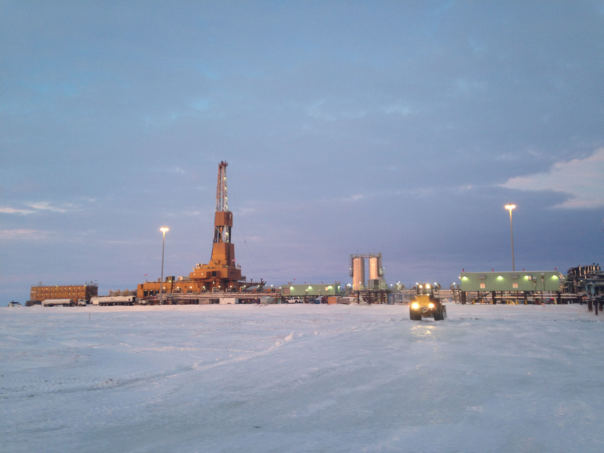
Oil development in the federally-managed National Petroleum Reserve-Alaska is now dominated by one company: ConocoPhillips. Conoco now controls over 1,000 square miles of the Reserve. Beyond its current developments, the company sees even more opportunity further west.
But in that direction lies the off-limits Teshekpuk Lake Special Area. Some groups think the whole area should stay protected. But Conoco is asking the federal government to re-draw the map.
Conoco is currently having a lot of success in the Reserve. For example, when the drill site CD5 came online two years ago, the company expected it to produce about 16,000 barrels of oil per day. Now, it’s putting out about 28,000 barrels per day.
CD5, on Alaska Native lands, was the first oil production inside the NPR-A boundary. Conoco is spending billions on two more projects west of CD5, called Greater Mooses Tooth 1 and Greater Mooses Tooth 2. Deeper into the reserve, Conoco sees even more potential. The company announced a massive oil discovery there in January, called the Willow discovery. Conoco thinks Willow could produce more than three times more oil per day than CD5.
This winter, Conoco aims to drill four exploration wells in the Reserve and one just outside it. That, by the way, is a lot.
“That’s big compared to any year — it’s a pretty substantial program we have going on this coming year,” Scott Jepsen, ConocoPhillips’ vice president of external affairs, said.
Jepsen said between all the oil exploration and construction happening in the Reserve this winter, Conoco is employing about 1,100 workers.
The Trump administration wants to continue this momentum. This year it offered 900 tracts of NPR-A at its oil and gas lease sale — the most ever.
But out of those 900 tracts, Conoco only bid on seven. That’s because the land that was available wasn’t where Conoco sees the most potential.
“In NPR-A, really, probably the most prospective acreage is due west of where we currently are,” Jepsen said.
And that land is off-limits to drilling, even though geologists see a lot of oil potential there. Conoco’s leases are now pushing up against a boundary set by the Obama administration back in 2013. That line is about 20 miles from Teshekpuk Lake, a huge Arctic lake surrounded by habitat for migratory birds and caribou. Jepsen says Conoco wants the boundary line to shift.
“We’ve been having conversations with the BLM about taking another look at that and seeing if some of that acreage can’t be made available for leasing,” Jepsen said.
Jepsen argued Conoco can pursue oil development near Teshekpuk Lake without putting caribou, bird species and subsistence for nearby communities at risk. He said some parts of the area are critical habitat and probably should stay off limits.
“But,” Jepsen said, “I think there are other areas that don’t fall into that category. And that we could demonstrate that we can safely develop those and develop them in an environmentally sound and sensitive manner.”
The Trump administration seems ready to listen. The Interior Department is re-evaluating the Obama-era decision that more than doubled the size of the protected area around Teshekpuk Lake.
But several environmental groups don’t think that land should be back on the table again. Nicole Whittington-Evans with the Wilderness Society in Anchorage said the boundaries in place now set a good balance between oil development and habitat protection.
“And if you start tinkering with it and shifting it, then you lose that balance,” Whittington-Evans said.
Unlike the Arctic National Wildlife Refuge to the east, the NPR-A is a place where environmental groups have been willing to compromise. Whittington-Evans said her group doesn’t oppose oil drilling in a lot of the Reserve.
“But in places where the ecology is so important and where species really depend on an area, we just don’t think these are appropriate places for the oil industry to be able to develop,” Whittington-Evans said. “And the Teshekpuk Lake Special Area is one of those places.”
Conoco’s ask to open up more of the Reserve to oil development — and environmental groups opposition to it — is being weighed in Washington, D.C. The Department of Interior will make the final decision but hasn’t said yet when that decision will be made.
Elizabeth Harball is a reporter with Alaska's Energy Desk, covering Alaska’s oil and gas industry and environmental policy. She is a contributor to the Energy Desk’s Midnight Oil podcast series. Before moving to Alaska in 2016, Harball worked at E&E News in Washington, D.C., where she covered federal and state climate change policy. Originally from Kalispell, Montana, Harball is a graduate of Columbia University Graduate School of Journalism.




